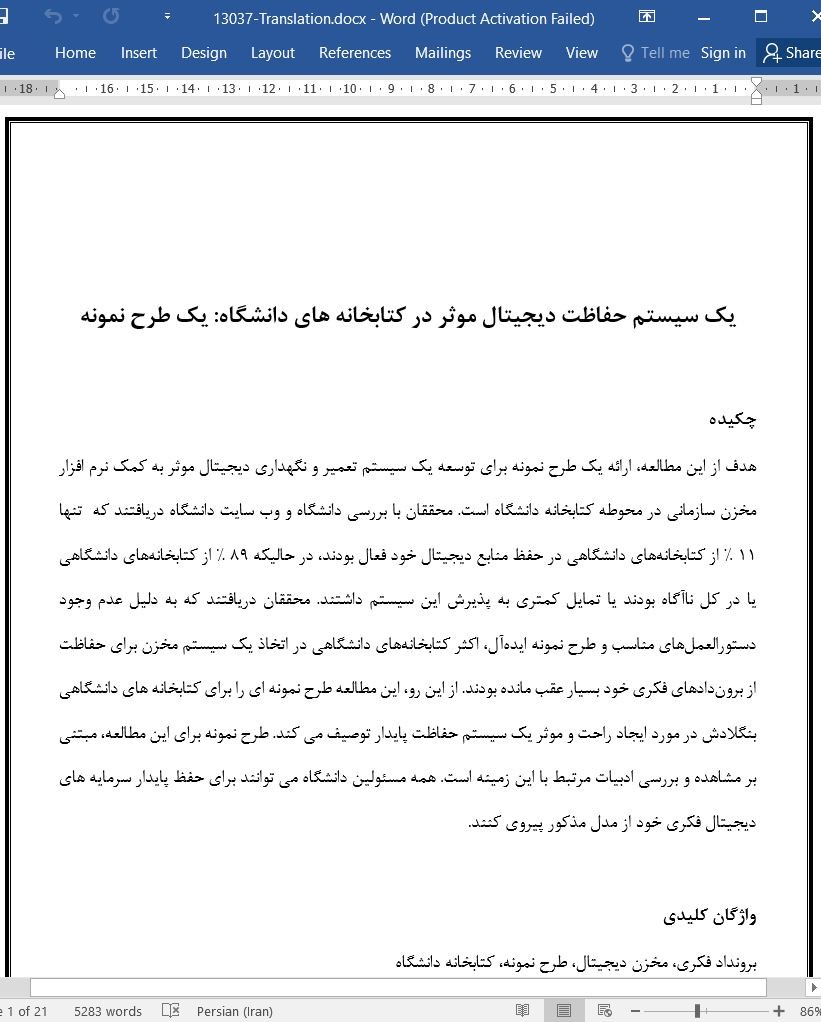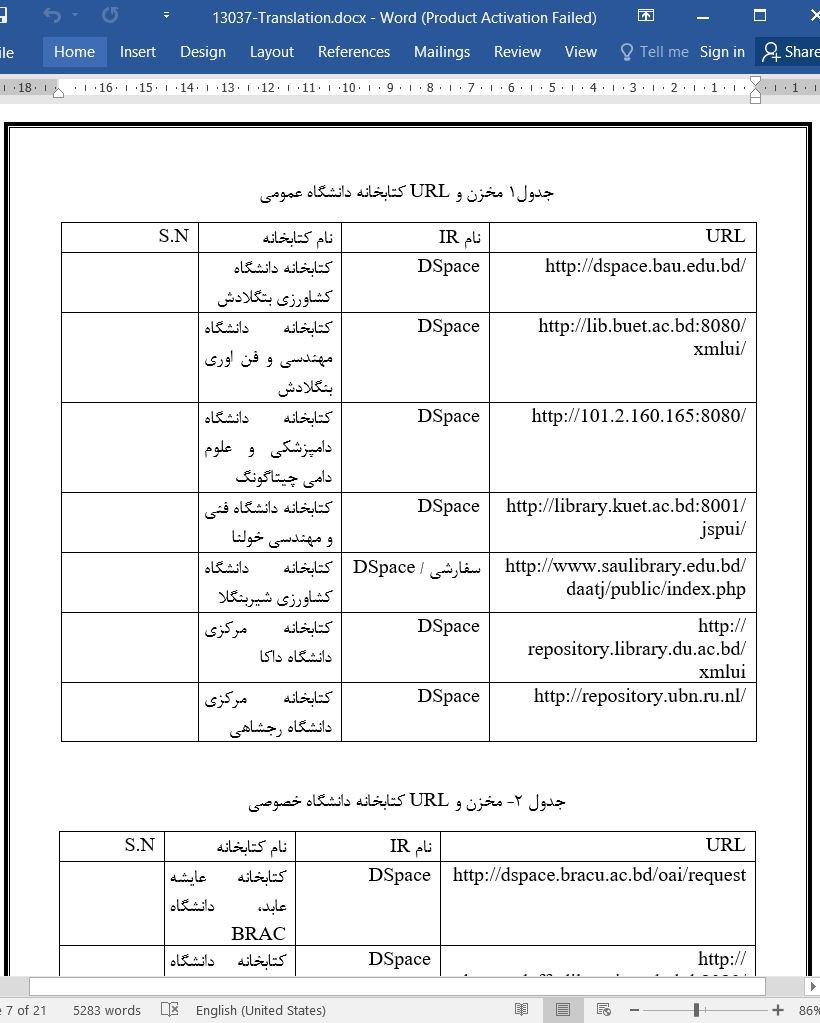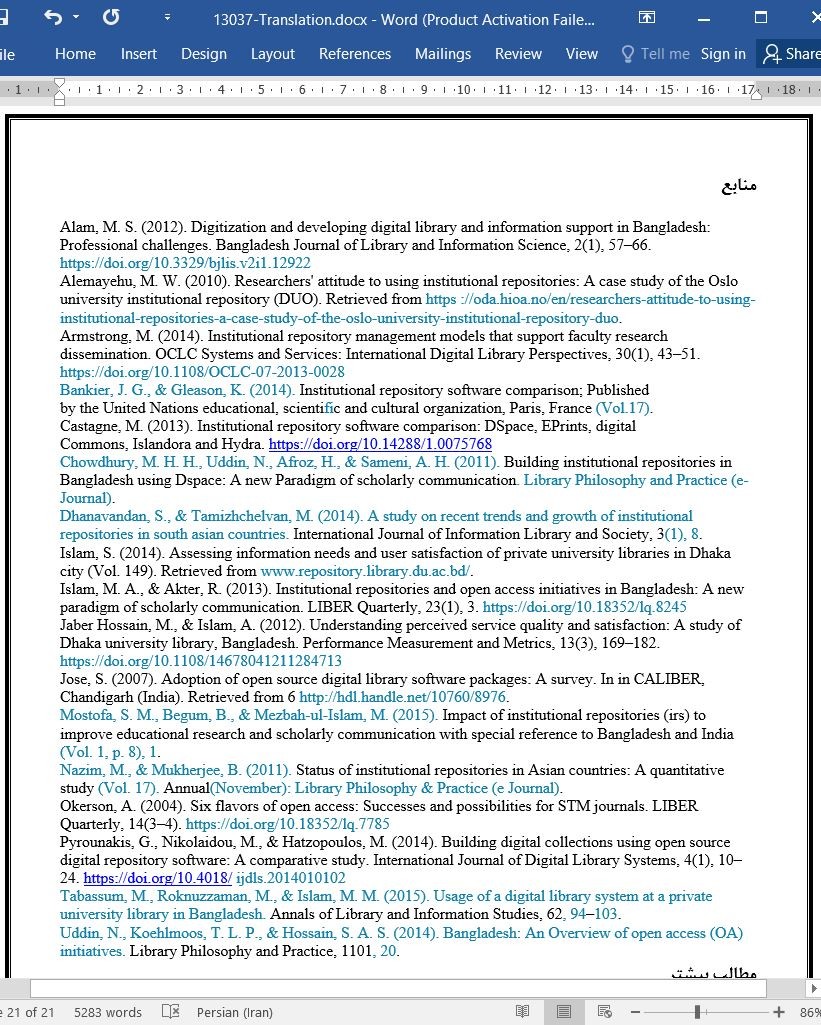
دانلود مقاله یک سیستم حفاظت دیجیتال موثر در کتابخانه های دانشگاه
چکیده
هدف از این مطالعه، ارائه یک طرح نمونه برای توسعه یک سیستم تعمیر و نگهداری دیجیتال موثر به کمک نرم افزار مخزن سازمانی در محوطه کتابخانه دانشگاه است. محققان با بررسی دانشگاه و وب سایت دانشگاه دریافتند که تنها 11 % از کتابخانههای دانشگاهی در حفظ منابع دیجیتال خود فعال بودند، در حالیکه 89 % از کتابخانههای دانشگاهی یا در کل ناآگاه بودند یا تمایل کمتری به پذیرش این سیستم داشتند. محققان دریافتند که به دلیل عدم وجود دستورالعملهای مناسب و طرح نمونه ایدهآل، اکثر کتابخانههای دانشگاهی در اتخاذ یک سیستم مخزن برای حفاظت از بروندادهای فکری خود بسیار عقب مانده بودند. از این رو، این مطالعه طرح نمونه ای را برای کتابخانه های دانشگاهی بنگلادش در مورد ایجاد راحت و موثر یک سیستم حفاظت پایدار توصیف می کند. طرح نمونه برای این مطالعه، مبتنی بر مشاهده و بررسی ادبیات مرتبط با این زمینه است. همه مسئولین دانشگاه می توانند برای حفظ پایدار سرمایه های دیجیتال فکری خود از مدل مذکور پیروی کنند.
1. مقدمه
بنگلادش، یکی از کشورهای محتمل و در مسیر توسعه در جهان است. دانشگاه های بنگلادش عمدتا به دو گروه دانشگاه های دولتی و خصوصی دسته بندی می شوند. بودجه دانشگاه های دولتی توسط دولت تامین می شود، در حالی که دانشگاه های خصوصی توسط سازمان های غیر دولتی و نهادهای خصوصی تامین می شوند. تعدادی دانشگاه بین المللی نیز در بنگلادش وجود دارد که توسط نهادهای بین المللی اداره و تأمین مالی می شوند. در حال حاضر 46 دانشگاه عمومی (دولتی)، 106 دانشگاه خصوصی (غیر دولتی) و 3 دانشگاه بین المللی در بنگلادش وجود دارد (UGC، 2, 020.). همه آنها از خدمات کتابخانه ای با امکانات نرم افزاری کتابخانه دیجیتال کم و بیش مدرنی برخوردارند. تجربه نشان داده است که کتابخانه های دانشگاهی بنگلادش تقریباً تمایل دارند که به جای ارائه خدمات به کاربران، به وضوح در «کلکسیون ها» قرار داده شوند؛ همچنین "رویه های اداری" را به جای سهولت استفاده؛ و "قوانین و مقررات" را به جای آنچه که کاربران می خواهند، ترجیح می دهند. اگرچه برخی از تحقیقات (Hossain & Islam ، 2012) در زمینه حفاظت دیجیتال انجام شده است، اما در اینجا کل خدمات کتابخانه مورد توجه و بررسی قرار گرفته است. مهم ترین مسئله محققان و پژوهشگران دانشگاه ها و سازمان های تحقیقاتی کشورهای در حال توسعه، عدم دسترسی به مقالات و تحقیقات روز در موضوعات مرتبط با آنهاست. از آنجایی که برونداد های مهم پژوهشی اغلب در مجلاتی منتشر می شوند که هزینه اشتراک بالایی دارند، جمع آوری مجلات مورد نیاز از ظرفیت اکثر کتابخانه ها فراتر می رود. همچنین در کشورهای در حال توسعه زیرساخت های تحقیقاتی و ظرفیت جذب دانش علمی و فنی ضعیف است و این امر منجر به کاهش بازده علمی و متعاقبا کاهش توسعه می شود (Islam & Akter2013; Okerson, 2004). در دهه گذشته، تعداد زیادی از سیستمهای کتابخانه دیجیتال (DL) و مخزن دیجیتال (DR) به عنوان نرم افزار منبع باز، توسعه یافته و منتشر شده اند. تنوع سیستم های نرم افزاری موجود در زمانی که یک سازمان قصد داشته باشد یک زیرساخت مخزن را برای میزبانی مجموعه های خود ایجاد کند، دردسرساز می شود (Pyrounakis و همکاران، 2014).
Abstract
The purpose of the study is to present a model plan for developing an effective digital maintenance system with the help of institutional repository software in university library premises. This work is an investigative study of digital maintenance activities for sustainable development of the digital publications and intellectual outputs of universities in Bangladesh. The researchers investigated the university and university website and found that only 11% university libraries were active in preserving their digital resources while 89% of university libraries were either in the dark or less reluctant to adopt the system. Researchers realized that due to lack of proper guidelines and an ideal model plan, most of the university libraries were far behind in adopting a repository system for safeguarding their intellectual outputs. Hence this study describes a model plan for the university libraries of Bangladesh to create a sustainable preservation system easily and effectively. The model plan in this study was based on observation and review of the literature in the concerned field. All university authorities can follow the mentioned model for sustainable maintenance of their intellectual digital assets.
1. Introduction
Bangladesh is one of the probable and on the way of developing country in the world. The universities of Bangladesh are mainly categorized into public and private universities. The public universities are funded by the government, whereas, private universities are funded by non-government organizations and private bodies. There are also a number of international universities in Bangladesh. These are governed and funded by international bodies. At present, there are 46 public (Government), 106 private (Non-government) and 03 international universities in Bangladesh (UGC, 2, 020.). All of them have their library services with more or less modern digital library software facilities. Experience exposed that the university libraries of Bangladesh are almost tended to be placed more overtly on “collections”, rather than on services to users; on “administrative procedures”, rather than on ease of use; and on “rules and regulations”, rather than on what users want. Although a number of researches (Hossain & Islam, 2012) were conducted on digital preservation, but, attention was paid on the judgment of total library services. The most important problem for scholars and researchers in universities and research organizations of developing countries is the lack of access to the current literature in their subjects. Since important research output is most often published in journals with high subscription fees, collecting the required journals exceeds the capacity of most libraries. Moreover, in developing countries also the research infrastructure and the capacity to absorb scientific and technical knowledge are weak, leading to low levels of scientific output and further under-development (Islam & Akter, 2013; Okerson, 2004). In the last decade a great number of Digital Library (DL) and Digital Repository (DR) systems have been developed and published as open-source software. The variety of available software systems becomes a headache when an organization plans to build a repository infrastructure to host its collections (Pyrounakis et al., 2014).
چکیده
1. مقدمه
2. اهداف مطالعه
3. مروری بر مقالات
4. موضوعات و روش
4.1. جمعیت و نمونه گیری
5. بیان مسئله
6. طرح نمونه
6.1 خصوصیات طرح نمونه
6.2 اهداف طرح نمونه
6.3 مزایای احتمالی
6.4 توابع طرح نمونه
6.5 محدوده طرح نمونه
6.6 استراتژی طرح
6.7 موانع احتمالی طرح نمونه
6.8. مولفه های طرح نمونه
6.9. سیستم کتابخانه دیجیتال منبع باز (OSDLS)
6.10. نرم افزار مخزن نهادی DSpace
6.11. مدیر مخزن
6.12. متخصص ماهر IR
6.13. باید آیتمها را جمع آوری کرد
6.14 رقابت توسعه ساختاری
6.15 فعالیت های عملیاتی
6.16 هدف
6.17 بخش IR
6.18 نظارت توسط UGCwing
6.19 رضایت کاربر
7. اعتبارسنجی مدل
8. نتیجه گیری
منابع
Abstract
1. Introduction
2. Objectives of the study
3. Literature review
4. Materials and method
4.1. Population and sampling
5. Statement of the problem
6. Model Plan
6.1. Characteristics of the model plan
6.2. Objectives of the model plan
6.3. Probable benefit
6.4. Functions of the model plan
6.5. Scope of the model plan
6.6. Strategy of the plan
6.7. Possible barriers of the model plan
6.8. Components of the model plan
6.9. Open source Digital Library System (OSDLS)
6.10. DSpace institutional repository software
6.11. Repositoryadministrator
6.12. Skilled IR professional
6.13. Items should be collected
6.14. Structural development competition
6.15. Operational activities
6.16. Target
6.17. IR section
6.18. Monitoring by UGCwing
6.19. User satisfaction
7. Model validation
8. Conclusion
Declaration of interests
References
این محصول شامل پاورپوینت ترجمه نیز می باشد که پس از خرید قابل دانلود می باشد. پاورپوینت این مقاله حاوی 16 اسلاید و 6 فصل است. در صورت نیاز به ارائه مقاله در کنفرانس یا سمینار می توان از این فایل پاورپوینت استفاده کرد.
در این محصول، به همراه ترجمه کامل متن، یک فایل ورد ترجمه خلاصه نیز ارائه شده است. متن فارسی این مقاله در 5 صفحه (1470 کلمه) خلاصه شده و در داخل بسته قرار گرفته است.
علاوه بر ترجمه مقاله، یک فایل ورد نیز به این محصول اضافه شده است که در آن متن به صورت یک پاراگراف انگلیسی و یک پاراگراف فارسی درج شده است که باعث می شود به راحتی قادر به تشخیص ترجمه هر بخش از مقاله و مطالعه آن باشید. این فایل برای یادگیری و مطالعه همزمان متن انگلیسی و فارسی بسیار مفید می باشد.
بخش مهم دیگری از این محصول لغت نامه یا اصطلاحات تخصصی می باشد که در آن تعداد 40 عبارت و اصطلاح تخصصی استفاده شده در این مقاله در یک فایل اکسل جمع آوری شده است. در این فایل اصطلاحات انگلیسی (تک کلمه ای یا چند کلمه ای) در یک ستون و ترجمه آنها در ستون دیگر درج شده است که در صورت نیاز می توان به راحتی از این عبارات استفاده کرد.
- ترجمه فارسی مقاله با فرمت ورد (word) با قابلیت ویرایش و pdf بدون آرم سایت ای ترجمه
- پاورپوینت فارسی با فرمت pptx
- خلاصه فارسی با فرمت ورد (word)
- متن پاراگراف به پاراگراف انگلیسی و فارسی با فرمت ورد (word)
- اصطلاحات تخصصی با فرمت اکسل



